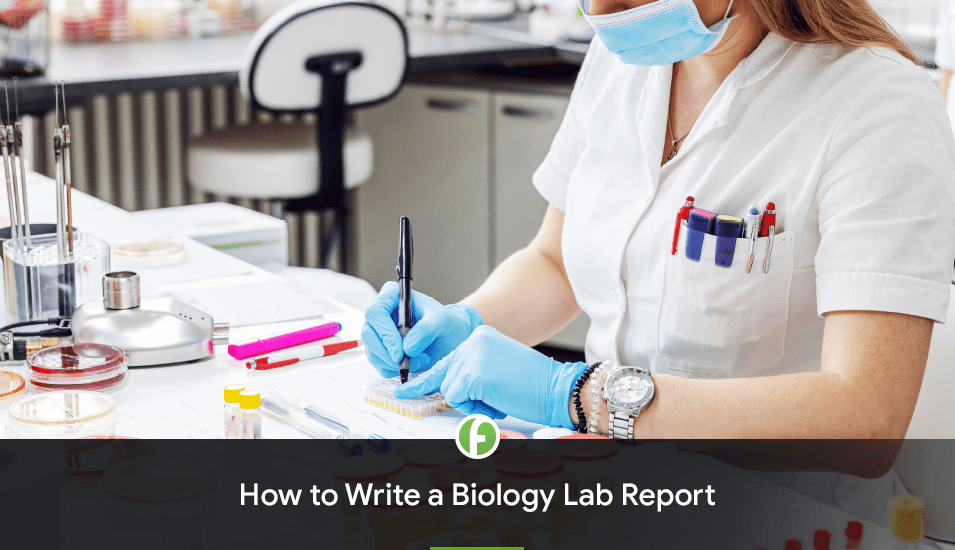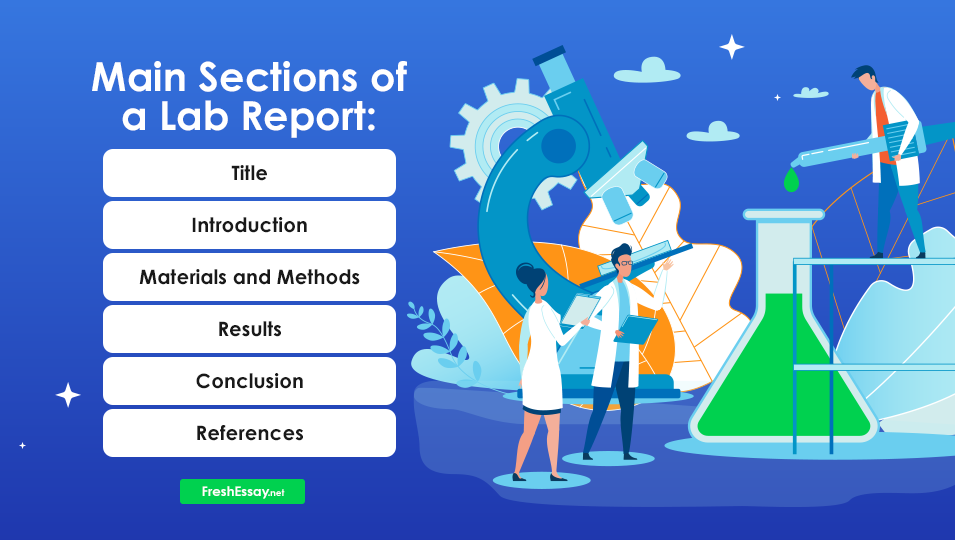Learn How to Write a Biology Lab Report

If you are taking a biology course, at some point, you will need to make an experiment and report about it. In case you have no idea how to write a biology lab report, then you should keep reading and we will provide you with a detailed explanation on how to create a winning piece. In fact, completing biology lab reports is an integral task for every student enrolling in Biology programs. The primary purpose of a biology report is to determine in what way did you perform your experiment, what is its theoretical and practical value, as well as how well you can explain this process. A well-written lab report is evidence that you:
- Understood all the stages of your experiment;
- Have managed to reach your goals;
- Can present the results of your experiment in an appropriate way.
Step-by-Step Guide: Writing a Biology Lab Report
Writing a biology lab report can seem daunting, but breaking the process into manageable steps makes it more approachable. This guide will take you through each step, providing tips and best practices while highlighting common mistakes to avoid.
Step 1: Understand the Purpose
- Purpose: Clearly define the purpose of your lab report. What is the experiment about? What are the objectives?
Step 2: Gather Data
- Collect Data: Carefully record all data during the experiment. Be accurate and thorough in your observations.
Step 3: Organize Your Thoughts
- Outline: Create an outline for your report. Decide on the structure, including sections like Introduction, Methods, Results, Discussion, and Conclusion.>
Step 4: Write the Introduction
- Background: Provide relevant background information about the experiment’s context.
- Hypothesis: State your hypothesis or research question.
- Objectives: Clearly outline the objectives of the experiment.
- Common Mistake: Avoid including results or detailed methods in the introduction.
Step 5: Describe the Methods
- Experimental Procedure: Explain the methods you used to conduct the experiment in a clear and concise manner.
- Materials: List all materials and equipment used.
- Common Mistake: Don’t omit crucial details; ensure another scientist could replicate your experiment based on your description.
Step 6: Present the Results
- Data Presentation: Display your data using tables, graphs, or figures.
- Labeling: Clearly label all figures and tables, including units of measurement.
- Common Mistake: Avoid interpreting results in this section; save that for the Discussion.
Step 7: Analyze and Discuss
- Interpretation: Interpret the results, explaining their significance and relevance to your hypothesis.
- Compare Findings: Compare your results to expected outcomes or previous research.
- Common Mistake: Don’t introduce new data or methods here; focus on the analysis.
Step 8: Draw Conclusions
- Summarize: Summarize the main findings and how they relate to your hypothesis.
- Reflect: Reflect on the implications of your findings.
- Common Mistake: Avoid making unsupported claims or overgeneralizing.
Step 9: Include References
- Cite Sources: Properly cite any sources, research papers, or textbooks you used.
- Formatting: Follow the citation style required (e.g., APA, MLA, or Chicago).
- Common Mistake: Don’t forget to cite sources; plagiarism is a serious offense.
Step 10: Proofread and Edit
- Proofread: Carefully proofread your lab report for grammatical errors and clarity.
- Formatting: Ensure your report adheres to formatting guidelines (e.g., font size, margins).
- Common Mistake: Neglecting to proofread can lead to misunderstandings and lower grades.
Step 11: Get Feedback
- Peer Review: Have a peer or classmate review your lab report for feedback.
- Instructor Feedback: Seek guidance from your instructor if available.
- Common Mistake: Skipping feedback can result in missed improvements.
Step 12: Finalize Your Report
- Final Draft: Create a final, polished version of your lab report.
- Appendices: If necessary, include appendices with raw data or additional information.
- Common Mistake: Rushing through the final draft can lead to overlooked errors.
Common Lab Report Format
Regardless of the topic, a lab report should include six main sections:

Pay attention that your tutor may provide you with different instructions and you need to follow them precisely if you want to receive a good grade.
How to Write a Biology Lab Report?
Let’s have a closer look at the main components of the lab report:
- Title. The title of your report should clearly state what you have done during your experiment. A good title should be accurate, descriptive, and concise. Depending on the formatting style, you may need to write a title page that should include the title of the lab report, the name of the student, the name of the supervisor, as well as the date of report submission;
- Introduction. When it comes to writing a lab report, an introduction aims to provide a brief summary of the experiment, as well as background information that should help the reader understand the experiment better. In your introduction, you also need to include a research hypothesis that will be proven in your report;
- Materials and methods. As can be seen from its title, this section should include information about the materials used in research, as well as the methods. Pay attention that you should not only provide the list of materials but also explain when, how, and where they were used. This section should be detailed enough to allow other researchers to repeat your experiment using your methods;
- Results. In the results section, you need to include all the data from your observations. This section should include appropriate tables, charts, graphs, and illustrations in order to help your reader understand your findings better. Keep in mind that this part of your lab report should only introduce your results without explaining them;
- Discussion. In the following section of your report, you need to analyze the data received and evaluate the value of your experiment. When writing this section, you should explain what did you learn during this experiment. Was your hypothesis correct? Were there any mistakes during the experiment? What could be done in another way?
- Conclusion. In the concluding paragraph of your lab report, you need to summarize your experiment and provide recommendations for other researchers. Pay attention that this part should not include new data;
- References. Any experiment should be based on meticulous research. If you have consulted some primary and secondary sources in the working process, you need to mention their bibliographic information in your reference list.
If you were asked to follow the APA biology lab report format, then your book entry should include the following details:
- Full name of the author/authors;
- The date of its publication;
- The full title of the book;
- Book edition (if there are a few of them);
- Place where the book was published;
- The name of the publisher.
For example:
Jackson, M. D. (2016). The life of microorganisms. 3rd Edition. New York, NY: Bricks State.
The journal entry will include the following details:
- Full name of the author/authors;
- The date of publication;
- The full title of the article;
- The volume along with the issue number;
- Page numbers.
For example:
Smith R. E. & Jefferson M. L. (2015). Desert creatures. Geography World. 122(5), 43-49.
If the formatting style is not indicated anywhere in your prompt, make sure to ask your tutor about it. It is particularly important to clarify all the important details before you start working on your lab report.
What Is an Abstract?
Some supervisors ask their students to put abstracts in their lab reports. In a nutshell, an abstract is a brief summary of your experiment. It should include accurate information about the experiment, the research hypothesis, the methods that were used for addressing the problems, the main results of the experiment, etc.
Typically, an abstract appears before the introduction. However, it is highly recommended to write it only when the rest of the report is completed.
Order a lab report written by a seasoned writer!
Lab Report Formatting
How to format a biology lab report? Check out the tips mentioned below:
- When writing your paper, make sure to choose an appropriate font. The font size should be not less than 12pt. As for the font type, you may use a traditional font such as Arial or Times New Roman;
- Use 1-inch margins on all sides of your lab report;
- Include page numbers for the proper navigation through your text;
- Add headings to all of your major sections.
For more detailed formatting requirements, make sure to check the manual of the citation style indicated in your prompt.
Do Not Forget About Proofreading
As soon as you are done with writing your paper, you need to revise it carefully. Although the main emphasis should be on the content and structure of your paper, good mechanics is also very important. As such, we highly recommend you check your paper for grammatical, spelling, and punctuation flaws. One more important point that will be assessed when checking your lab report is its compliance with instructions. As such, if you want to receive a good grade for your paper, you need to follow the professor’s guidelines precisely.
A good lab report is always original and authentic. By copying the ideas of other people, you will be accused of plagiarism, which will have a negative effect on your academic performance. As such, when revising your lab report, do not forget to scan it through the reliable plagiarism detection tools. Only if your work is free from unoriginal content, you may submit it.
Get proofreading help in our professional proofreading service.
Essential Glossary for Biology Lab Report Writing
Here’s a glossary of key terms and concepts related to lab report writing and biology to help students better understand the terminology:
- A
- Abstract: A concise summary of the lab report, including the purpose, methods, results, and conclusions.
- B
- Control Group: A group in an experiment that remains unchanged and is used as a reference point to compare with experimental groups.
- Hypothesis: A testable prediction or educated guess about the outcome of an experiment.
- C
- Data: The information or measurements collected during an experiment.
- Conclusion: A summary of the results and the interpretation of their significance in relation to the hypothesis.
- Discussion: The section of a lab report where results are analyzed and interpreted in the context of the research question.
- E
- Experiment: A controlled procedure designed to test a hypothesis and collect data.
- F
- Figures: Visual representations, such as graphs or charts, used to present data in a lab report.
- I
- Introduction: The beginning section of a lab report that provides background information, states the hypothesis, and outlines the objectives.
- M
- Materials: A list of all equipment and supplies used in the experiment.
- Methods: A section of the lab report that details the step-by-step procedures used to conduct the experiment.
- P
- Peer Review: The process of having other experts in the field evaluate and provide feedback on a scientific paper or lab report.
- Variables: Factors that can change or affect the outcome of an experiment, including independent, dependent, and controlled variables.
- R
- Results: The section of a lab report that presents data and findings in a clear and organized manner.
- References: A list of sources, such as research papers or textbooks, cited in the lab report.
- S
- Scientific Method: A systematic approach to conducting experiments, including making observations, forming hypotheses, conducting tests, and drawing conclusions.
- Conclusion: A summary of the experiment’s findings and their implications, typically found at the end of a lab report.
- T
- Tables: Organized sets of data presented in rows and columns in a lab report.
- Theory: A well-substantiated explanation of a natural phenomenon based on a large body of evidence and scientific consensus.
- Thesis Statement: A concise statement in the introduction that summarizes the main point or purpose of the lab report.
- V
-
Variables:
- Independent Variable: The variable that is deliberately changed or manipulated in an experiment.
- Dependent Variable: The variable that responds to changes in the independent variable.
- Controlled Variables: Factors that are kept constant to ensure a fair and accurate experiment.
This glossary provides you with a solid foundation of key terms and concepts commonly used in lab report writing and biology, helping you communicate effectively and understand the terminology in their coursework.
Expert Academic Help
If you don’t know how to do a lab report for biology you can always order it at our lab report service. Our company has been assisting students in pursuing their academic goals for many years. All our customers receive premium quality, support, and care because we highly appreciate their willingness to cooperate with us. The cost of our services is very reasonable because we do not want to be a financial burden on the shoulders of our clients. In other words, we can guarantee that by placing your order at our writing platform, you will be satisfied with our approach to work. In case you are ready to order a lab report or you just want to learn more about our company, you can contact our support representatives and they will gladly assist you.
Don't lose time, order now!
Choose the best topic, set the deadline and get any of your papers written according to all of your demands with perfect timing. We provide individual approach to each client.
Frequently Asked Questions About Lab Report Writing
- What is the purpose of a lab report?
Answer: The primary purpose of a lab report is to communicate the results and findings of a scientific experiment. It allows others to understand your methodology, analyze your data, and evaluate your conclusions.
- What should be included in the introduction of a lab report?
Answer: The introduction should provide background information, state the research question or hypothesis, and outline the objectives of the experiment. It sets the stage for the reader and explains the context of your research.
- How do I format a lab report?
Answer: Lab reports typically follow a structured format, including sections like Introduction, Methods, Results, Discussion, Conclusion, and References. Ensure proper formatting of headings, font size, and margins as per your instructor’s guidelines.
- What is the difference between the Methods and Results sections?
Answer: The Methods section describes how the experiment was conducted, including the procedures and materials used. The Results section presents the data and findings obtained from the experiment, often using tables, figures, or graphs.
- How do I analyze and interpret my results?
Answer: In the Results section, analyze your data by identifying patterns, trends, and relationships. Interpret the significance of these findings in the context of your hypothesis and the broader scientific context.
- What should be included in the Discussion section?
Answer: In the Discussion section, explain the meaning of your results, discuss their implications, and compare them to previous research or expectations. Address any limitations or sources of error and suggest areas for future research.
- How do I cite sources in my lab report?
Answer: Use a citation style such as APA, MLA, or Chicago to format your references. Include in-text citations whenever you reference external sources, and provide a list of full citations in the References section.
- What are controlled variables in an experiment?
Answer: Controlled variables, also known as constants, are factors that are intentionally kept constant throughout the experiment to ensure that they do not influence the results. They provide a baseline for comparison.
- How do I write a strong abstract for my lab report?
Answer: A strong abstract should briefly summarize the purpose, methods, results, and conclusions of your lab report. It should be concise, clear, and informative, providing a snapshot of your study.
- What should I do if my results do not support my hypothesis?
Answer: If your results do not support your hypothesis, it’s important to discuss this in the Discussion section. Analyze the reasons for the unexpected outcome and consider alternative explanations. Scientific discoveries often arise from unexpected results.
- How do I proofread and edit my lab report effectively?
Answer: To proofread and edit your lab report, read it carefully for grammar, spelling, and clarity. Check for consistency in formatting and ensure that your ideas flow logically. Consider seeking feedback from peers or instructors.
- Is it acceptable to use the first-person point of view in a lab report?
Answer: In most scientific writing, including lab reports, it is customary to use the third-person point of view and avoid personal pronouns (e.g., “I” or “we”). However, always follow your instructor’s guidelines, as some may permit the use of the first person in certain sections.
- How long should a lab report be?
Answer: The length of a lab report can vary but is typically determined by your instructor’s guidelines. It should be long enough to effectively convey your methods, results, and analysis while remaining concise and focused on relevant information.
- What is the role of peer review in lab report writing?
Answer: Peer review involves having other experts or peers in the field evaluate and provide feedback on your lab report. It helps ensure the quality and validity of your work and provides constructive input for improvement.


